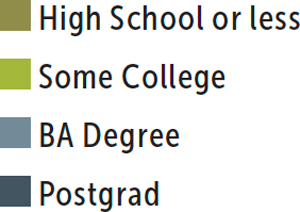Alaska Trends
Y
ou probably already know this, but STEM stands for Science, Technology, Engineering, and Mathematics. And you’ve probably also heard that careers in STEM provide some of the most lucrative opportunities in the state of Alaska. But did you know that by 2029, the US Bureau of Labor Statistics estimates that there will be 797,800 new STEM jobs in the United States? This is a projected growth rate of 8 percent, compared to the non-STEM occupation growth rate of 3.4 percent.
At its core, the aim of STEM education is to develop the next wave of problem solvers and critical thinkers. These are the engineers, the architects, and other lovers of mathematics that ensure Alaska’s bridges are sturdy—and our economy sturdier.
8% Projected Growth by 2029

Nationally, STEM occupations are projected to grow by 8 percent by 2029 compared to non-STEM occupations, projected to grow by 3.4 percent.
(US Bureau of Labor Statistics)
8% Projected Growth by 2029

Nationally, STEM occupations are projected to grow by 8 percent by 2029 compared to non-STEM occupations, projected to grow by 3.4 percent.
(US Bureau of Labor Statistics)


9.7 Million STEM Jobs in 1990

17.3 Million STEM Jobs in 2018
17.3+ Million Jobs
Employment in STEM occupations has grown 79% since 1990, from 9.7 million to 17.3 million nationwide. These occupations include computer, math, engineering, and architecture. STEM careers also include physical and life scientists and health-related jobs such as healthcare practitioners and technicians.
(Pew Research Center)
797,800 New Jobs
In total, it is estimated there will be 797,800 new STEM jobs in the United States by 2029.
(US Bureau of Labor Statistics)

2.2% vs 5.5% Unemployment
Nationally, the STEM unemployment rate is 2.2% while the non-STEM unemployment rate is 5.5%.
(Education Commission of the States)
3 in 10
Overall, about three-in-ten STEM workers report having completed an associate degree or have some college education but no degree.
(Pew Research Center)



5x Faster
US jobs that demand technical training are growing 5 times faster than those that don’t.
(National Math & Science Initiative)

(Pew Research Center)
Higher Income
STEM workers enjoy a pay advantage compared with non-STEM workers with similar levels of education.
The STEM Advantage in ALASKA
STEM workers in Alaska earn an average of $73,000 a year, $28,000 more per year on average than non-STEM workers.
(Alaska Department of Labor)


24×2
Licensed Engineers in Alaska must complete 24 hours of professional development every 2 years.
(Alaska State Board of Registration for Architects, Engineers & Land Surveyors)

$39 vs. $19 Wage
The median hourly wage for STEM jobs in the United States is $38.85 per hour ($86,980 annually), compared to $19.30 for all other jobs.
(Education Commission of the States)
Specialties
Engineering specialties in Alaska
Agricultural
Chemical
Civil
Control Systems
Electrical
Environmental
Fire Protection
Industrial
Chemical
Civil
Control Systems
Electrical
Environmental
Fire Protection
Industrial
Mechanical
Metallurgical and Mineral Processing
Naval Architecture and Marine
Nuclear
Petroleum
Structural
Metallurgical and Mineral Processing
Naval Architecture and Marine
Nuclear
Petroleum
Structural
(Alaska Department of Commerce, Community, and Economic Development)
Cold Climate Course
An Arctic Engineering class is required to be a licensed Engineer or Architect in Alaska.
